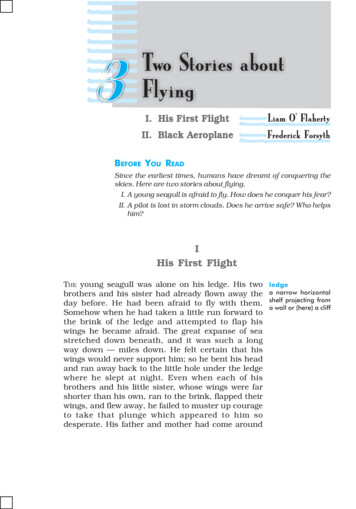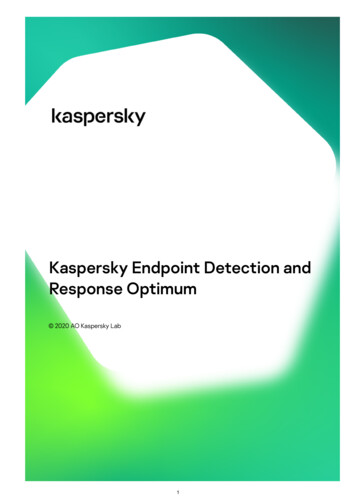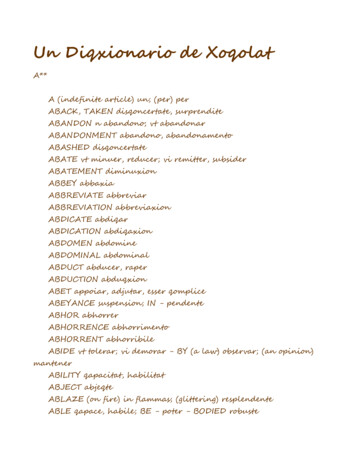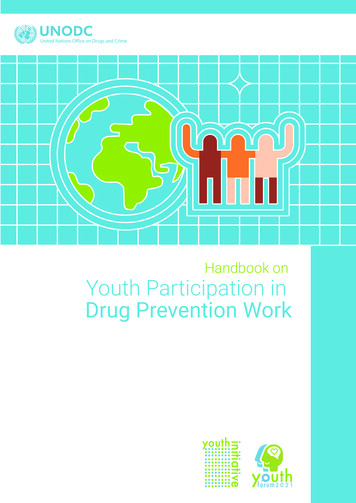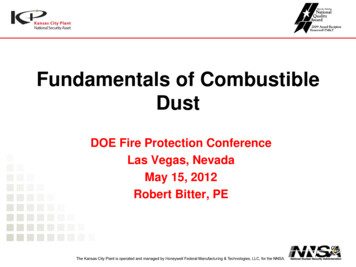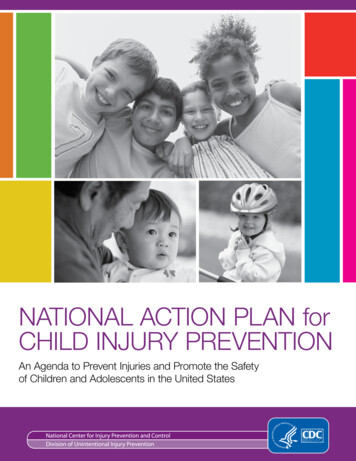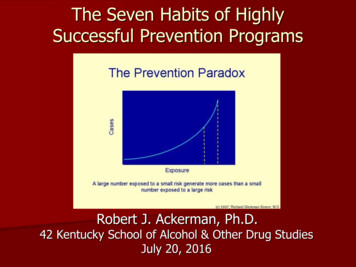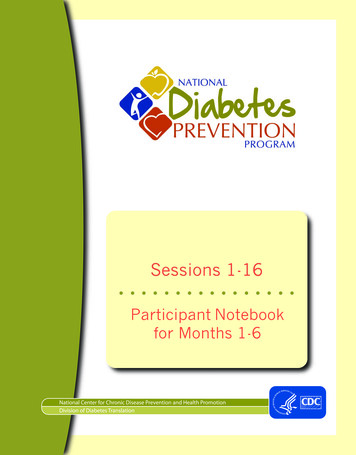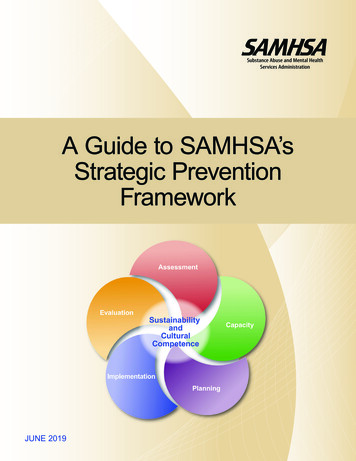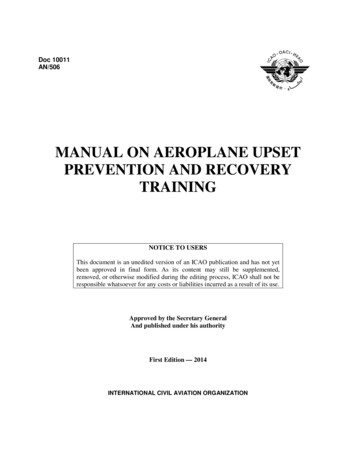
Transcription
Doc 10011AN/506MANUAL ON AEROPLANE UPSETPREVENTION AND RECOVERYTRAININGNOTICE TO USERSThis document is an unedited version of an ICAO publication and has not yetbeen approved in final form. As its content may still be supplemented,removed, or otherwise modified during the editing process, ICAO shall not beresponsible whatsoever for any costs or liabilities incurred as a result of its use.Approved by the Secretary GeneralAnd published under his authorityFirst Edition — 2014INTERNATIONAL CIVIL AVIATION ORGANIZATION
Published in separate English, French, Russian,Arabic, Chinese and Spanish editions by theINTERNATIONAL CIVIL AVIATION ORGANIZATION999 University Street, Montréal, Quebec, Canada H3C 5H7For ordering information and for a complete listing of sales agentsand booksellers, please go to the ICAO website at www.icao.intFirst Edition, 2014Doc 10011, Manual on Aeroplane Upset Prevention and Recovery TrainingOrder Number: 10011ISBN xxx-xx-xxxx-xxx-x ICAO 2014All rights reserved. No part of this publication may be reproduced, stored in a retrieval system or transmittedin any form or by any means, without prior permission in writing from the International Civil AviationOrganization.
AMENDMENTSAmendments are announced in the supplements to the Catalogue of ICAO Publications; the Catalogue andits supplements are available on the ICAO website at www.icao.int. The space below is provided to keep arecord of such amendments.RECORD OF AMENDMENTS AND CORRIGENDAAMENDMENTSNo.DateCORRIGENDAEntered byNo.(iii)DateEntered by
FOREWORDBetween 2001 and 2011, aeroplane accidents resulting from a loss of control in flight (LOC-I)event were the leading cause of fatalities in commercial aviation. LOC-I accidents often have catastrophicresults with very few, if any, survivors.Following a conference in June 2009 on aeroplane upsets and loss of control in flight, the RoyalAeronautical Society (RAeS) initiated a study to investigate the LOC-I phenomena and makerecommendations on mitigating strategies, notably with respect to potential improvements to internationalcivil aviation standards and guidance material. This work was undertaken by the RAeS InternationalCommittee on Aviation Training in Extended Envelopes (ICATEE). ICAO supported this initiative.In 2011, the Federal Aviation Administration (FAA) of the United States of Americacommissioned an aviation rulemaking committee (ARC) to develop effective upset prevention and recoverytraining methodologies. In 2012, ICAO, the European Aviation Safety Agency (EASA) and the FAAdecided to combine efforts to identify and establish an acceptable approach to reduce such occurrences.ICAO sponsored seven meetings in 2012 during which Civil Aviation Authorities (CAAs), the FAA ARCand subject matter experts were encouraged to participate in focused discussions. Also, as several initiativeswere underway simultaneously that sought to reduce the number of LOC-I events, ICAO brought many ofthe groups involved with these efforts into the ensuing discussions under what became known as the loss ofcontrol avoidance and recovery training (LOCART) initiative.Reducing the number of LOC-I accidents is an ICAO priority, and ICAO has developedharmonized training requirements for flight crews that address and mitigate LOC-I events. Supported byICATEE and the FAA ARC, ICAO has introduced improvements to existing Standards and RecommendedPractices (SARPs) and corresponding guidance material. Both on-aeroplane training at the commercial pilotand multi-crew pilot level and training in a flight simulation training device at the airline transport pilot andtype rating level are now promulgated in Annexes 1 — Personnel Licensing and 6 — Operation of Aircraft,Part I — International Commercial Air Transport — Aeroplanes, as well as in the Procedures for AirNavigation Services – Training (PANS-TRG, Doc 9868,), with an applicability date of 13 November 2014.This manual provides guidance to support these new provisions and is only applicable to the training ofaeroplane pilots.The content of the manual was developed over a period of three years with input from manygroups of experts from aircraft and flight simulator manufacturers, pilot representative organizations,airlines, training organizations, accident investigation bureaus, human performance specialists, etc., and wasthereafter submitted for an extensive peer review to collect and take into account comments from the expertcommunity. It is based upon the latest forms of technology available at the time of its publication. As such,it will be subject to a revision process that will be governed in large part by changing dynamics within theindustry. Comments on this manual, particularly with respect to its application, usefulness and scope ofcoverage, would be appreciated. These will be taken into consideration in the preparation of subsequenteditions. Comments concerning the manual should be addressed to:The Secretary GeneralInternational Civil Aviation Organization999 University Street,Montréal, Québec H3C 5H7Canada(iv)
TABLE OF CONTENTSPublicationsAbbreviations and AcronymsDefinitionsSECTION 1.INTRODUCTION TO THE MANUAL1.1 Aeroplane upset defined1.2 Upset prevention and recovery training — genesis1.3 Manual — applicabilitySECTION 2.TRAINING PROGRAMME REQUIREMENTS2.1 Approach and components of UPRT design2.2 Training elements of UPRTSECTION 3.TRAINING3.1 Overview3.2 Academic training3.3 Practical training3.3.1 Aeroplane training3.3.2 FSTD training3.3.2.1 Overview3.3.2.2 Non-type-specific FSTD training3.3.2.3 Type-specific FSTD training3.4 OEM recommendations — FSTD training scenarios3.4.1 Overview3.4.2 Recommended training sequences3.5 OEM recommendations — upset recovery techniquesSECTION 4.FSTD FIDELITY REQUIREMENTS FOR UPRT4.1 Overview4.2 Fidelity requirements for UPRT and stall training4.2.1 Introduction4.2.2 Flight model dynamics improvements4.2.3 Aeroplane model performance improvements4.2.4 Aeroplane model cueing improvements4.3 FSTD scenario-based training requirements for UPRT4.4 Instructor tool requirements for UPRTSECTION 5.UPRT INSTRUCTORS5.1 Overview5.2 Instructor qualification(v)
(vi)Manual on Aeroplane Upset Prevention and Recovery Training5.2.1 Academic instructors5.2.2 On-aeroplane instructors5.2.3 FSTD instructors5.3 UPRT competency-based programmes — instructorsSECTION 6.6.16.26.36.46.56.6REGULATORY OVERSIGHTOverviewUPRT training philosophyTraining risk mitigationQA and SMS evaluationsImplementing UPRTApproval and on-going surveillanceAPPENDIX:COMPETENCY-BASED UPRT PROGRAMMES1.Applicability2.Understanding competency-based training3.Pilot core competencies — example4.UPRT practical training — CBT assessments5.Performance-based regulatory ��––––––––
PUBLICATIONS(used in this manual)Convention on International Civil Aviation (Doc 7300)Annex 1 — Personnel LicensingAnnex 6 — Operation of Aircraft , Part I — International Commercial Air Transport — AeroplanesAnnex 19 — Safety ManagementProcedures for Air Navigation Services – Training (PANS-TRG, Doc 9868)Manual of Procedures for Establishment and Management of a State’s Personnel Licensing System(Doc 9379)Manual of Criteria for the Qualification of Flight Simulation Training Devices (Doc 9625), Volume I —AeroplanesManual on the Approval of Training Organizations (Doc 9841)Safety Management Manual (Doc 9859)Manual of Evidenced-Based Training (Doc 9995)Airplane Upset Recovery Training Aid (AURTA) – Revision 2 (by an industry and government workinggroup) or any future revision (references to sections of the AURTA in this manual are for the Revision 2).RAeS ICATEE Research and Technology ReportFlight Simulation Training Device Design and Performance Data Requirements (IATA)FAA Advisory Circular, AC 120-109 – Stall and Stick Pusher ––––––––(vii)
ABBREVIATIONS AND OFTMPLMTOMOEMPFPIOAeroplaneAutopilotAutothrottle (equivalent to A/THR depending on the aeroplane manufacturer)AutothrustAbove aerodrome levelAirborne collision avoidance systemAttitude director indicatorAbove ground levelAeroplane nose downAeroplane nose upAngle of attackAppendixAviation rule-making committeeAir traffic controlApproved training organizationAvions de transport régionalAirplane upset recovery training aidCivil Aviation AuthorityCompetency-based trainingCentre of gravityCommercial pilot licence (aeroplane)Crew resource managementEuropean Aviation Safety AgencyEvidence-based trainingFederal Aviation Administration (of the United States of America)Fly-by-wireFlight simulation training deviceFeetIndicated airspeedInternational Air Transport AssociationInternational committee for aviation training in extended envelopesInstructor operating stationInstructional systems designKnowledge, skills and attitudesPoundLearning management systemLoss of control avoidance and recovery trainingLoss of control, in-flightLine-oriented flight trainingLine-operational simulationMeterMaximum operating Mach numberManoeuvre-oriented flight trainingMulti-crew pilot licenceMaximum take-off massOriginal equipment manufacturer(s)Pilot flyingPilot induced oscillation(viii)
VrefVsvs.VTEManual on Aeroplane Upset Prevention and Recovery TrainingPilot monitoringPilot not flying (equivalent to PM)Quality assuranceRoyal Aeronautical SocietyStandards and recommended practices (ICAO)Safety management systemStandard operating procedureState safety programmeThreat and error managementTake-offTake-off/go-aroundUndesired aeroplane stateUpset prevention and recovery trainingCruising SpeedMaximum operating speedReference speed in the landing configurationVstallVersusValid training ––––––––
DEFINITIONSWhen the subsequent terms are used in this manual, they have the following meanings:Academic training. Training that places an emphasis on studying and reasoning designed to enhanceknowledge levels of a particular subject, rather than to develop specific technical or practical skills.Accountable executive. The individual who has corporate authority for ensuring that all trainingcommitments can be financed and carried out to the standard required by the civil aviation authority(CAA), and any additional requirements defined by the approved training organization.Aerodynamic stall. An aerodynamic loss of lift caused by exceeding the critical angle of attack(synonymous with the term ‘stall’).Aeroplane upset. An airplane in flight unintentionally exceeding the parameters normally experienced inline operations or training, normally defined by the existence of at least one of the followingparameters:a)b)c)d)pitch attitude greater than 25 degrees, nose up; orpitch attitude greater than 10 degrees, nose down; orbank angle greater than 45 degrees; orwithin the above parameters, but flying at airspeeds inappropriate for the conditions.Airmanship. The consistent use of good judgement and well-developed knowledge, skills and attitudes toaccomplish flight objectives.Angle of attack (AOA). Angle of attack is the angle between the oncoming air, or relative wind, and adefined reference line on the aeroplane or wing.Approach-to-stall. Flight conditions bordered by stall warning and aerodynamic stall.Approved training organization (ATO). An organization approved by and operating under the supervisionof a Contracting State in accordance with the requirements of Annex 1 to perform approved training.Assessment. The determination as to whether a candidate meets the requirements of the expectedperformance standard.Autoflight systems. The autopilot, autothrottle (or autothrust), and all related systems that perform automaticflight management and guidance.Behaviour. The way a person responds, either overtly or covertly, to a specific set of conditions, which iscapable of being measured.Behavioural indicator. An overt action performed or statement made by any flight crew member thatindicates how an individual or the crew is handling an event.Bridge training. Additional training designed to address shortfalls in knowledge and skill levels so that alltrainees possess the pre-requisite levels upon which the approved training programme was designed.(x)
(xi)Manual on Aeroplane Upset Prevention and Recovery TrainingCompetency. A combination of skills, knowledge, and attitudes required to perform a task to the prescribedstandard.Competency-based training. Training and assessment that are characterized by a performance orientation,emphasis on standards of performance and their measurement and the development of training to thespecified performance standards.Competency element. An action that constitutes a task that has a triggering event and a terminating eventthat clearly defines its limits, and an observable outcome.Contributing factor. A reported condition that contributed to the development of an aircraft accident orincident.Core competencies. A group of related behaviours, based on job requirements, which describe how toeffectively perform a job and what proficient performance looks like. They include the name of thecompetency, a description, and a list of behavioural indicators.Critical angle of attack. The angle of attack that produces the maximum coefficient of lift beyond which anaerodynamic stall occursCritical system malfunctions. Aeroplane system malfunctions that place significant demand on a proficientcrew. These malfunctions should be determined in isolation from any environmental or operationalcontext.Developed upset. A condition meeting the definition of an aeroplane upset.Developing upset. Any time the aeroplane begins to unintentionally diverge from the intended flight path orairspeed.Energy. The capacity to do work.Energy state. How much of each kind of energy (kinetic, potential or chemical) the aeroplane has availableat any given time.Error. An action or inaction by the flight crew that leads to deviations from organizational or flight crewintentions or expectations.Error management. The process of detecting and responding to errors with countermeasures that reduce oreliminate the consequences of errors, and mitigate the probability of further errors or undesiredaeroplane states.Evidence-based training (EBT). Training and assessment based on operational data that is characterised bydeveloping and assessing the overall capability of a trainee across a range of core competencies ratherthan by measuring the performance of individual events or manoeuvres.Note.— Guidance on EBT is contained in the Procedures for Air Navigation Services – Training(PANS-TRG, Doc 9868) and the Manual of Evidence-based Training (Doc 9995). EBT is competency-basedand is applicable, as an option, to the recurrent training of flight crew members engaged in commercial airtransport operations that is conducted in an FSTD.Fidelity level. The level of realism assigned to each of the defined FSTD features.
Definitions(xii)First Indication of a stall. The initial aural, tactile or visual sign of an impending stall, which can be eithernaturally or synthetically induced.Flight crew member. A licensed crew member charged with duties essential to the operation of an aeroplaneduring a flight duty period.Flight management system. An aeroplane computer system that uses a large database to permit routes to bepre-programmed and fed into the system by means of a data loader. The system is constantly updatedwith respect to position accuracy by reference to the most appropriate navigation aids available, whichare automatically selected during the information update cycle.Flight path. The trajectory or path of an object (aeroplane) travelling through the air over a given space oftime.Flight simulation training device (FSTD). A synthetic training device that is in compliance with theminimum requirements for FSTD qualification as described in Doc 9625.Instructional systems design (ISD). A formal process for designing training which includes analysis, designand production, and evaluation phases.Instructor. A person authorised to provide academic or practical training to a trainee or trainee for anaviation licence, rating or endorsement.Line-orientated flight training. Training and assessment involving a realistic, ‘real time’, full missionsimulation of scenarios that are representative of line operations.Load factor. The ratio of a specified load to the weight of the aeroplane, the former being expressed in termsof aerodynamic forces, propulsive forces, or ground reactions.Manoeuvres. A sequence of deliberate actions to achieve a desired flight path. Flight path control may beaccomplished by a variety of means including manual aeroplane control and the use of autoflightsystems.Manoeuvre-based training. Training that focuses on a single event or manoeuvre in isolation.Motion turnaround bumps. A phenomenon associated with FSTD motion actuators when their direction oftravel reverses, which results in acceleration spikes that can be felt by the pilot thus giving a falsemotion cue.Negative training. Training which unintentionally introduces incorrect information or invalid concepts,which could actually decrease rather than increase safety.On-aeroplane training. A component of a UPRT programme designed to develop skill sets in employingeffective upset prevention and recovery strategies utilizing only suitably-capable light aeroplanes.Performance criteria. Simple, evaluative statements on the required outcome of the competency elementand a description of the criteria used to measure whether the required level of performance has beenachieved.Phase of flight. A defined period within a flight.
(xiii)Manual on Aeroplane Upset Prevention and Recovery TrainingNote.— E.g. take-off, climb, cruise, descent, approach and landing.Post-stall regime. Flight conditions at an angle of attack greater than the critical angle of attack.Practical training. Describes training that places an emphasis on the development of specific technical orpractical skills, which is normally preceded by academic training.Quality assurance (QA). All the planned and systematic actions necessary to provide adequate confidencethat all activities satisfy given standards and requirements, including the ones specified by the approvedtraining organization in relevant manuals.Note.— This definition is specific to this manual.Quality management. A management approach focused on the means to achieve product or service qualityobjectives through the use of its four key components: quality planning; quality control; qualityassurance; and quality improvement.Note.— This definition is specific to this manual.Quality System. The aggregate of all the organization’s activities, plans, policies, processes, procedures,resources, incentives and infrastructure working in unison towards a total quality management approach.It requires an organizational construct complete with documented policies, processes, procedures andresources that underpin a commitment by all employees to achieve excellence in product and servicedelivery through the implementation of best practices in quality management.Note.— This definition is specific to this manual.Scenario. Part of a training module plan that consists of predetermined manoeuvres and training events.Scenario-based training. Training that incorporates manoeuvres into real-world experiences to cultivatepractical flying skills in an operational environment.Stall. An aerodynamic loss of lift caused by exceeding the critical angle of attack.Note.— A stalled condition can exist at any attitude and airspeed, and may be recognized by continuousstall warning activation accompanied by at least one of the following:a) buffeting, which could be heavy at times;b) lack of pitch authority and/or roll control; andc) inability to arrest the descent rate;Stall Event. An occurrence whereby the aeroplane experiences conditions associated with an approach-tostall or an aerodynamic stall.Stall recovery procedure. The manufacturer-approved aeroplane-specific stall recovery procedure. If amanufacturer-approved recovery procedure does not exist, the aeroplane-specific stall recoveryprocedure developed by the operator based on the stall recovery template contained in the FAAAdvisory Circular, AC 120-109.Stall warning. A natural or synthetic indication provided when approaching a stall that may include one or
Definitions(xiv)more of the following indications:a)b)c)d)e)f)aerodynamic buffeting (some airplanes will buffet more than others);reduced roll stability and aileron effectiveness;visual or aural cues and warnings;reduced elevator (pitch) authority;inability to maintain altitude or arrest rate of descent; andstick shaker activation (if installed).Note.— A stall warning indicates an immediate need to reduce the angle of attack.Startle. The initial short-term, involuntary physiological and cognitive reactions to an unexpected event thatcommence the normal human stress response.Stick shaker. A device that automatically vibrates the control column to warn the pilot of an approachingstall.Note.— A stick shaker is not installed on all aeroplane types.Stick pusher. A device that, automatically applies a nose down movement and pitch force to an aeroplane’scontrol columns, to attempt to decrease the aeroplane’s angle of attack. Device activation may occurbefore or after aerodynamic stall, depending on the aeroplane type.Note.— A stick pusher is not installed on all aeroplane types.Stress (response). The response to a threatening event that includes physiological, psychological andcognitive effects. These effects may range from positive to negative and can either enhance or degradeperformance.Surprise. The emotionally-based recognition of a difference in what was expected and what is actual.Threat. Events or errors that occur beyond the influence of the flight crew, increase operational complexityand must be managed to maintain the margin of safety.Threat management. The process of detecting and responding to threats with countermeasures that reduceor eliminate the consequences of threats and mitigate the probability of errors or undesired aeroplanestates.Train-to-proficiency. Approved training designed to achieve end-state performance objectives, providingsufficient assurances that the trained individual is capable to consistently carry out specific tasks safelyand effectively.Note.— In the context of this definition, the words train-to-proficiency can be replaced by training-toproficiency.Training event. Part of a training scenario that enables a set of competencies to be exercised.Training objective. A clear statement that is comprised of three parts, i.e.:a) the desired performance or what the trainee is expected to be able to do at the end of training(or at the end of particular stages of training);
(xv)Manual on Aeroplane Upset Prevention and Recovery Trainingb) the conditions under which the trainee will demonstrate competence; andc) the performance standard to be attained to confirm the trainee’s level of competence.Transport category aeroplane. A category of airworthiness applicable to large civil aeroplanes, which areeither:a) Turbojets with 10 or more seats or having a maximum take-off mass (MTOM) of greater than5 700 kg (12 566 lb); orb) Propeller-driven aeroplanes with greater than 19 seats or a MTOM greater than 8618 kg(19 000 lb).Unsafe situation. A situation, which has led to an unacceptable reduction in safety margin.Wake encounter. An event characterized by the aeroplane experiencing the effects of wake turbulencebrought about by wingtip vortices or engine ––––––––––––
SECTION 1.INTRODUCTION TO THE MANUAL1.1 Aeroplane Upset Defined1.1.1The term “aeroplane upset” is defined in the glossary as an in-flight condition by whichunintentionally an aeroplane exceeds the parameters normally experienced in normal line operations ortraining. An upset is generally recognized as a condition of flight during which the pitch of the aeroplaneunintentionally exceeds either 25 degrees nose up or 10 degrees nose down; or a bank angle exceeding45 degrees; or flight within the aforementioned parameters but at inappropriate airspeeds.1.1.2For the purposes of continuity, “aeroplane upset” will be the term used throughout this manualrecognizing that there are several other terms in use within the aviation industry referring to this particulartype of occurrence. When reading this manual it is important to be clear on two points about aeroplaneupsets. First is the notion of unintentional. In other words, the aeroplane is not doing what it was intended todo by the flight crew and is approaching unsafe parameters. Second is the fact that a pilot must not wait untilthe aeroplane is in a fully developed upset before taking recovery action to return to stabilized flight pathparameters. The term “loss of control in-flight” (LOC-I) is a categorization of an accident or incidentresulting from a deviation from the intended flight path.1.1.3Finally, it is important to understand that there is a relationship to the definitions of ‘stall’ and‘upset’. Although not all aeroplane upset occurrences involve an aerodynamic stall, an unintentional stall isindeed a form of upset even though it may not meet the pitch and bank attitude upset parameters. This isbecause during a stall the aeroplane meets the upset criteria of being at an inappropriate airspeed for theconditions. In all instances of an aeroplane upset involving a stall, it is stressed in this manual that theaeroplane must first be recovered from the stall condition before any other upset recovery action can becomeeffective. Therefore, since upset and stall events are closely related, it is highly desirable to ensure that anycomprehensive training programme for the prevention and recovery from a stall be closely linked withtraining for the prevention and recovery of aeroplane upsets.1.2 Upset Prevention and RecoveryTraining — Genesis1.2.1The number of fatalities resulting from LOC-I events involving commercial air transportaeroplanes has led to an examination by several organisations regarding current training practices.1.2.2As mentioned in the Foreword, by 2012 several initiatives were underway each seeking toreduce the number of LOC-I events. Committees and working groups had been formed to study industrytrends, advancements in simulation technologies, training requirements, aeroplane equipment design, andhuman performance. These initiatives included an aviation rulemaking committee (ARC) set up in 2011 bythe Federal Aviation Administration (FAA) of the United States of America. In 2012, ICAO and the FAAbrought many of the groups involved with these initiatives into the ensuing discussions under what becameknown as the loss of control avoidance and recovery training (LOCART) initiative through which CivilAviation Authorities (CAAs), pilot representatives, aeroplane manufacturers and subject matter experts wereencouraged to participate in focused discussions.1.2.3This initiative revealed that some existing practices were found to be not only ineffective, butwere also considered a contributory factor in inappropriate responses by some flight crews. For example, incertain cases, the methodologies being applied in training and checking a recovery from an approach-to-stall1-1
1-2Manual on Aeroplane Upset Prevention and Recovery Trainingcondition of flight were based on the pilot being able to achieve recovery with a minimal loss of altitude.This resulted in training practices emphasizing the importance of a rapid application of power with the leastamount of reduction in angle of attack (AOA) to minimize the loss of altitude rather than appreciating theimportance of reducing the angle of attack to effectively restore the ability of the wing to generate lift.Action has now been taken by both regulators and training providers to amend such procedures with newtraining and testing standards emphasizing that effective recovery from an approach-to-stall requires,foremost, an immediate and deliberate reduction in the angle of attack. Crews must also be made aware thatthis required reduction in AOA, whenever the aeroplane is encountering low energy states while operating athigh altitudes, might even necessitate a substantial loss in altitude to ensure that an effective recovery froman impending or actual aerodynamic stall condition is achieved.1.2.4Analysis of LOC-I accident data indicated that contributory factors can be categorized as beingeither: aeroplane systems induced; environmentally induced; pilot/human induced; or any combination ofthese three factors. Of the three, pilot-induced accidents represented the most frequently-identified cause ofthe event, principally resulting from one or more of the following reasons:a)b)c)d)e)application of improper procedures, including inappropriate flight control inputs;one or more flight crew members becoming spatially disoriented;poor aeroplane energy management;one or more flight crew members being distracted; orimproper training.1.2.5There are also several recorded incidents of aeroplane upsets from which there was indeed asuccessful recovery and many other occurrences where an impending upset was avoided. The determinantfactor for recovery to a safe state in most of those incidents was either the flight crew’s accurate analysis ofthe occurrence and the timely and correct application of preventive/recovery techniques, or the aeroplane’sinherent stability combined with its envelope protection system that provided an added measure of time, oran auto-flight system input that marginalized the seriousness of the incident.1.2.6The LOCART initiative resulted in the following recommendations for implementingimprovements to existing training practices by integrating a comprehensive upset prevent
Practices (SARPs) and corresponding guidance material. Both onaeroplane training at the commercial pilot - and multi-crew pilot level and training in a flight simulation training device at the airline transport pilot and type rating level are now promulgated in Anne
